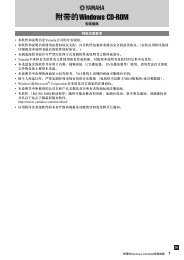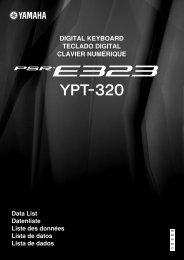Create successful ePaper yourself
Turn your PDF publications into a flip-book with our unique Google optimized e-Paper software.
● Tone Generator<br />
The DTXPRESS’ tone generator contains a total of 910 drum and<br />
percussion voices.<br />
Preset <strong>Drum</strong> Kits use an exclusive <strong>Drum</strong> Kit Map for each kit in<br />
which voices for the kit are assigned to individual MIDI note numbers.<br />
The User <strong>Drum</strong> Kit uses one drum map (User <strong>Drum</strong> Map) that is<br />
common for all drum kit numbers 49-80. The Utility mode’s [5.<br />
Map (<strong>Drum</strong> Map)] group can be used to assign voices to each<br />
MIDI note number (0-127) and edit the drum kit.<br />
Along with the DTXPRESS’ drum and percussion voices, the<br />
DTXPRESS possesses a variety of keyboard voices (128 voices)<br />
that are based on the GM System Level 1. It is possible to deliver<br />
piano and brass voices by hitting the pad and playback songs with<br />
the internal sequencer or from external sequencer data. A maximum<br />
of 32 voices can be delivered simultaneously.<br />
● Song Data<br />
The DTXPRESS contains 95 preset songs (No. 1-95) that consist<br />
of not only drum parts but also keyboard, brass, etc., accompaniment<br />
parts.<br />
You can enjoy the songs as they are or mute the song’s drums or a<br />
single drum voice (snare drum, etc.) and play along with the drum.<br />
Also, you can record your performance to the User Song memory<br />
(No. 96-127). Each song consists of two tracks and each track can<br />
include data for MIDI channels 1-16.<br />
● MIDI/TO HOST Jacks<br />
All drum kit setting data and sequencer data are managed with a<br />
MIDI data.<br />
By connecting the DTXPRESS’ MIDI OUT/IN jacks to the MIDI<br />
IN/OUT jacks on an external MIDI device, MIDI data can be exchanged.<br />
The TO/HOST jack is used to transmit and receive MIDI<br />
data from a computer.<br />
According to the MIDI data transmitted from an external MIDI<br />
device or computer connected to the DTXPRESS, drum kits can<br />
be switched, the song can be controlled and the tone generator can<br />
be sounded freely.<br />
For example, song data (sequencer data) transmitted from an external<br />
sequencer to the DTXPRESS’ MIDI IN jack can be used to<br />
play the voices produced by the DTXPRESS’ internal tone generator.<br />
You can use the DTXPRESS to play along with these songs<br />
and record both external sequencer and DTXPRESS parts.<br />
Also, MIDI data produced when the DTXPRESS can be transmitted<br />
to an external MIDI device and/or computer. Playing the<br />
DTXPRESS in this configuration allows you to trigger the external<br />
tone generator’s voices and when a drum kit is switched, have<br />
the external MIDI keyboard’s voice change as well. The<br />
DTXPRESS’ data can be stored to, as well as retrieved from an<br />
external MIDI device.<br />
DTXPRESS Internal Makeup<br />
■ Basic Operations for Data Setting<br />
● Enter the Modes<br />
Press each Mode button.<br />
Double-click a button to jump directly to the specified page the<br />
mode you want to enter.<br />
• <strong>Drum</strong> Kit Play Mode .............................. [PLAY]<br />
• Trigger Setup Edit Mode ....................... [TRIG]<br />
• Utility Mode ........................................... [UTIL]<br />
• <strong>Drum</strong> Kit <strong>Voice</strong> Edit Mode .................... [VOICE]<br />
• Song Job Mode ..................................... [SONG]<br />
● Page Navigation<br />
Press the [PAGEs] button to move to the previous page, the<br />
[PAGEt] button to move to the next page. Hold the button to<br />
scroll through the pages.<br />
● Select the Parameter<br />
The flashing parameter on the display is specified for setting.<br />
• Use the [SEL] buttons to move the cursor (the<br />
flashing character or symbol).<br />
The [SEL] moves the cursor to the right.<br />
• When there is only one parameter on the display, the [SEL] buttons will not operate.<br />
● Change the setting<br />
The setting (value) of flashing parameter on the display can be<br />
changed.<br />
• The [VALUE–] and [VALUE+] buttons are used to set parameter<br />
values.<br />
When setting values, press the [VALUE–] button to decrease<br />
(minus) the value, press the [VALUE+] button to increase (plus)<br />
the value. Holding the button will continue to decrease/increase<br />
the value.<br />
Hold the [VALUE–] and press the [VALUE+] button will decrease<br />
the value by 10. Continue to hold both buttons and the<br />
value will continue to decrease.<br />
Hold the [VALUE+] button and press the [VALUE–] button to<br />
increase the value by 10. Continue to hold both buttons and the<br />
value will continue to increase.<br />
5




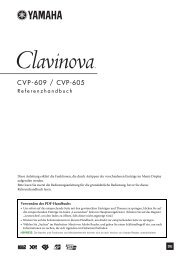

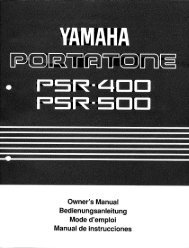

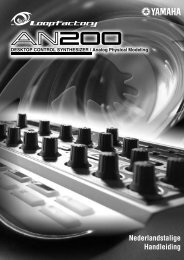
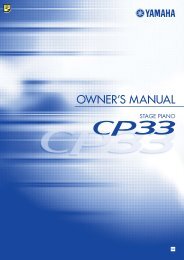


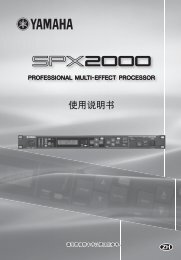
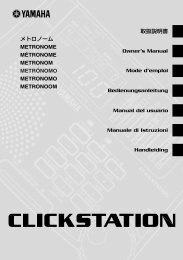
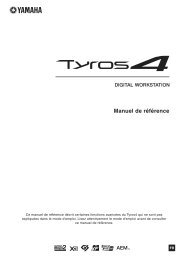
![Premere il pulsante [SONG] - Yamaha](https://img.yumpu.com/50419553/1/184x260/premere-il-pulsante-song-yamaha.jpg?quality=85)
